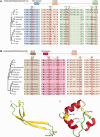Evidence for Adaptation to the Tibetan Plateau Inferred from Tibetan Loach Transcriptomes
- PMID: 26454018
- PMCID: PMC5635588
- DOI: 10.1093/gbe/evv192
Evidence for Adaptation to the Tibetan Plateau Inferred from Tibetan Loach Transcriptomes
Abstract
Triplophysa fishes are the primary component of the fish fauna on the Tibetan Plateau and are well adapted to the high-altitude environment. Despite the importance of Triplophysa fishes on the plateau, the genetic mechanisms of the adaptations of these fishes to this high-altitude environment remain poorly understood. In this study, we generated the transcriptome sequences for three Triplophysa fishes, that is, Triplophysa siluroides, Triplophysa scleroptera, and Triplophysa dalaica, and used these and the previously available transcriptome and genome sequences from fishes living at low altitudes to identify potential genetic mechanisms for the high-altitude adaptations in Triplophysa fishes. An analysis of 2,269 orthologous genes among cave fish (Astyanax mexicanus), zebrafish (Danio rerio), large-scale loach (Paramisgurnus dabryanus), and Triplophysa fishes revealed that each of the terminal branches of the Triplophysa fishes had a significantly higher ratio of nonsynonymous to synonymous substitutions than that of the branches of the fishes from low altitudes, which provided consistent evidence for genome-wide rapid evolution in the Triplophysa genus. Many of the GO (Gene Ontology) categories associated with energy metabolism and hypoxia response exhibited accelerated evolution in the Triplophysa fishes compared with the large-scale loach. The genes that exhibited signs of positive selection and rapid evolution in the Triplophysa fishes were also significantly enriched in energy metabolism and hypoxia response categories. Our analysis identified widespread Triplophysa-specific nonsynonymous mutations in the fast evolving genes and positively selected genes. Moreover, we detected significant evidence of positive selection in the HIF (hypoxia-inducible factor)-1A and HIF-2B genes in Triplophysa fishes and found that the Triplophysa-specific nonsynonymous mutations in the HIF-1A and HIF-2B genes were associated with functional changes. Overall, our study provides new insights into the adaptations and evolution of fishes in the high-altitude environment of the Tibetan Plateau and complements previous findings on the adaptations of mammals and birds to high altitudes.
Keywords: Tibetan Plateau; Triplophysa fishes; accelerated evolution; adaptation; transcriptome.
© The Author(s) 2015. Published by Oxford University Press on behalf of the Society for Molecular Biology and Evolution.
Figures




Similar articles
-
Transcriptome analysis of the plateau fish (Triplophysa dalaica): Implications for adaptation to hypoxia in fishes.Gene. 2015 Jul 10;565(2):211-20. doi: 10.1016/j.gene.2015.04.023. Epub 2015 Apr 11. Gene. 2015. PMID: 25869933
-
Comprehensive Transcriptome Analysis of Six Catfish Species from an Altitude Gradient Reveals Adaptive Evolution in Tibetan Fishes.G3 (Bethesda). 2015 Nov 12;6(1):141-8. doi: 10.1534/g3.115.024448. G3 (Bethesda). 2015. PMID: 26564948 Free PMC article.
-
Genomic and functional evidence reveals convergent evolution in fishes on the Tibetan Plateau.Mol Ecol. 2021 Nov;30(22):5752-5764. doi: 10.1111/mec.16171. Epub 2021 Oct 2. Mol Ecol. 2021. PMID: 34516715
-
Tibetan and Andean patterns of adaptation to high-altitude hypoxia.Hum Biol. 2000 Feb;72(1):201-28. Hum Biol. 2000. PMID: 10721618 Review.
-
Adaptive genetic changes related to haemoglobin concentration in native high-altitude Tibetans.Exp Physiol. 2015 Nov;100(11):1263-8. doi: 10.1113/EP085035. Exp Physiol. 2015. PMID: 26454145 Review.
Cited by
-
Genomic Evidence for Convergent Molecular Adaptation in Electric Fishes.Genome Biol Evol. 2021 Mar 1;13(3):evab038. doi: 10.1093/gbe/evab038. Genome Biol Evol. 2021. PMID: 33638979 Free PMC article.
-
Transcriptome analyses provide insights into the phylogeny and adaptive evolution of the mangrove fern genus Acrostichum.Sci Rep. 2016 Oct 26;6:35634. doi: 10.1038/srep35634. Sci Rep. 2016. PMID: 27782130 Free PMC article.
-
Characterization and functional analysis of hypoxia-inducible factor HIF1α and its inhibitor HIF1αn in tilapia.PLoS One. 2017 Mar 9;12(3):e0173478. doi: 10.1371/journal.pone.0173478. eCollection 2017. PLoS One. 2017. PMID: 28278251 Free PMC article.
-
Comprehensive Transcriptome Analysis Provides Evidence of Local Thermal Adaptation in Three Loaches (Genus: Misgurnus).Int J Mol Sci. 2016 Nov 24;17(12):1943. doi: 10.3390/ijms17121943. Int J Mol Sci. 2016. PMID: 27886141 Free PMC article.
-
High-Altitude Andean H194R HIF2A Allele Is a Hypomorphic Allele.Mol Biol Evol. 2023 Jul 5;40(7):msad162. doi: 10.1093/molbev/msad162. Mol Biol Evol. 2023. PMID: 37463421 Free PMC article.
References
-
- Awwad K, et al. 2015. Role of secreted modular calcium-binding protein 1 (SMOC1) in transforming growth factor beta signalling and angiogenesis. Cardiovasc Res. 106:284–294. - PubMed
Publication types
MeSH terms
Substances
Associated data
LinkOut - more resources
Full Text Sources
Other Literature Sources
Molecular Biology Databases

